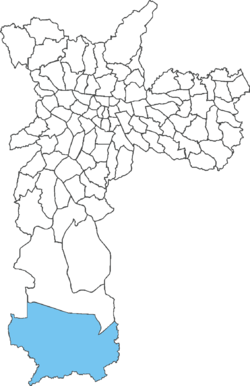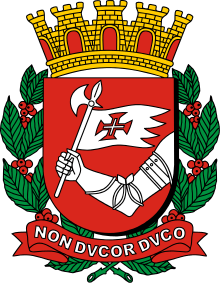Marsilac
Coordinates: 23°53′13″S 46°42′50″W / 23.887°S 46.714°W
| Marsilac | |
|---|---|
 Location of Marsilac in São Paulo | |
| Country |
|
| State |
|
| Municipality |
|
| Subprefecture | Parelheiros |
| Area | |
| • Total | 200 km2 (80 sq mi) |
| Population (2010) | |
| • Total | 8,258 |
| • Density | 41/km2 (110/sq mi) |
| Website | Subprefecture of Parelheiros |
Marsilac is one of 96 districts of São Paulo, located in the extreme south tip of the city in the subprefecture of Parelheiros.[1] Its name is a tribute to engineer Jose Alfredo Marsilac, who developed many techniques for building roads and tunnels, even after losing 99% of his vision from being hit by a bomb in the Revolution of 1932.
History
Early settlement of the area owed mainly to the construction of the Sorocabana Railroad connecting Mairinque and Santos, completed in 1935. Along its extension, there were three stations in the district: Engineer Marsilac (which gave name to the surrounding neighborhood and later to its own district), Evangelista de Souza, and Rio de Campos.
Features
Located near the Serra do Mar and almost entirely rural, Marsilac has the largest land area of the municipality, equivalent to all of the municipality's central area. It also has the lowest population density of all the districts, largely covered by reserves of the Atlantic Forest.
This is the most remote district of the capital, located about 60–70 kilometers from Marco Zero and only about 10–15 km from the Atlantic Ocean, which is visible from some points. It borders the municipalities of São Vicente and Itanhaém. A tiny area of the town lies at sea level, located in the Capivari River valley.
It is the poorest district and has the lowest Human Development Index (HDI) of the city of São Paulo.
Adjacent districts and municipalities
- Parelheiros (North)
- Municipality of São Bernardo do Campo (East)
- City of Itanhaém and São Vicente (South)
- City of Juquitiba and Embu-Guaçu (West)
Neighborhoods of Marsilac
- Bela Vista
- Capivari
- Chácara Sanni
- Embira
- Embuara
- Embura
- Engenheiro Marsilac
- Evangelista de Sousa
- Gramado
- Jardim dos Eucaliptos
References
- ↑ "Dados Demográficos dos Distritos pertencentes as Subprefeituras". prefeitura.sp.gov.br (in Portuguese). City of São Paulo. Retrieved 28 December 2014.
